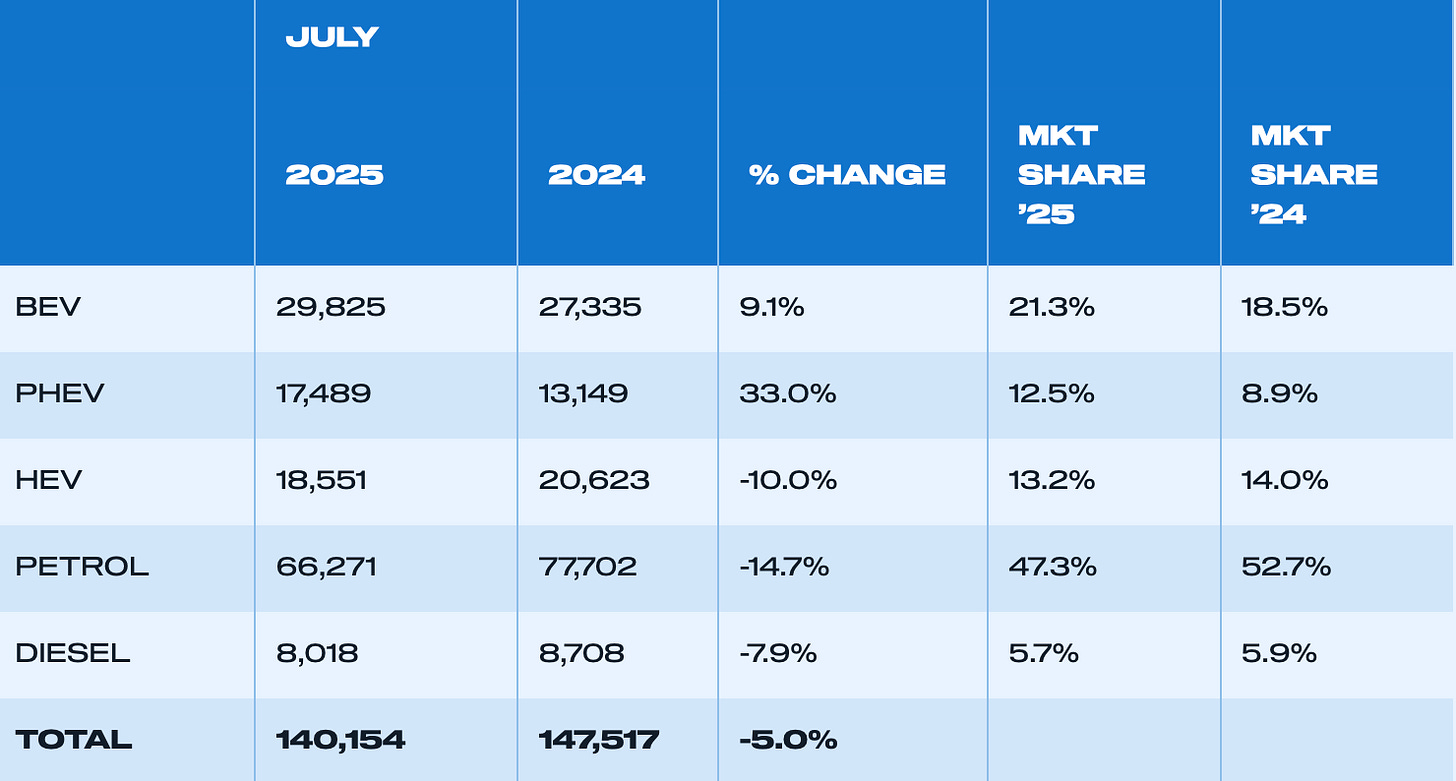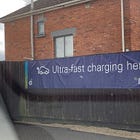Exclusive: Shell drops 50,000 EV charger target
Oil giant cites delays by OZEV for adjusting its network ambitions
Hello, I’m Tom Riley, and welcome back to The Fast Charge, a British EV newsletter.
Top story in today’s free edition… The UK oil giant Shell has dropped plans to install 50,000 EV chargers via ubitricity, laying the blame on the government for delaying the start of its local funding scheme.
Elsewhere… Charging curves, new vehicle registrations, and DfT reveal the first EVs to be eligible for a £1,500 grant.
As ever, if you have any comments or feedback, please reply to this email or message me on LinkedIn.
Shell drops its target of installing 50,000 EV chargers
Summary: Four years after announcing an ambitious plan to install 50,000 on-street EV chargers by the end of 2025, I can exclusively reveal that Shell is “no longer aiming to hit a numerical target of charge points” in the UK.
Background: Shell’s EV charger target was first revealed back in 2021. At the time, the whole globe was alight with optimism about the EV sector. COP26 was on the horizon for Britain, and investors started pouring millions into EV charging. The announcement of Shell’s target for 50,000 charge points came hot on the heels of the oil giant acquiring ubitricity, which was leading the market by retrofitting existing lampposts with chargers. This process is cheap and quick, so the 50,000 ambition was seen as achievable.
Today, ubitricity remains the UK’s biggest charging network. As of this month, the network became the first in Britain to hit 10,000 charge points (Read more). It’s a significant milestone, meaning one in eight public chargers are operated by Shell.
However… Mathematicians amongst you will realise, Shell would need to pull off an EV charging miracle to meet its original target. When I asked the company this week whether the target had proved too ambitious, they said it was a fair ask. And I am surprised it’s taken this long to acknowledge that.
In 2022… I interviewed ubitricty’s then Managing Director, Toby Butler, about its high growth plans. Even back then, Toby conceded it was a stretch. Extract below...
“The 50,000 target is really ambitious, that is really stretching ourselves, though we 100% believe we can get to it,” Toby defended adding that “Shell is fully committed to the EV transition, and I’m sure some people think ‘are you sure?’ but then I always point to the actual evidence.” -- Taken from my interview with ubitricity in 2022.
So, what went wrong? Based on the company’s explanation, it seems they lay the blame firmly at Westminster’s door, as the company cites both the “myriad” of changes over recent years, and the fact that the government’s Local EV Infrastructure scheme has only recently started awarding funding.
In a statement to The Fast Charge, ubitricity’s UK Managing Director, Stuart Wilson, commented:
“Ubitricity's strategic vision to roll out mass public EV charging infrastructure for the UK has not changed since Toby's comments in 2022. The public EV landscape has seen a myriad of changes in that time which has caused us to revisit and adjust our initial target of 50,000 charge points by the end of 2025. Whilst we are aiming for high growth we are no longer aiming to hit a numerical target of charge points.
“As you will be aware, OZEV published their welcoming £353M LEVI funding solely focussing on speeding up the deployment of on street public charging infrastructure. Unfortunately, this funding scheme has been significantly delayed with the first actual LEVI tender being awarded on the 7th April 2025, as of today we have only seen around 50% of the projected tenders being released.
“In terms of ubitricity's growth since 2022, we are really excited that our market share for public charging has been maintained demonstrating that our growth strategy remains on track.”
This is quite a veiled jab from Shell at the government. And while I’m certain there will be those who argue that their target withdrawal is ‘another example of big oil wriggling out of climate action’, I believe many other executives in the charging industry will empathise with Shell’s position. The government has been disjointed. Grid connectivity has been chaotic. And while many local areas are great, many others are run by absolute nutters. Anyway, to me, this story shows that, even with all the money in the world, you can’t just turn up at a site and get cracking.
Further to their statement, a spokesperson for ubitricity explained to me they were now all aligned with Shell’s wider EV business. In an additional statement, ubitricity said:
“As we continue to expand our public EV charging network, we’re prioritising investment in increasing utilisation of our existing public charging infrastructure in the UK and growing where demand is strongest. Our ambition is to build a strong, reliable, and highly utilised network that delivers profitable growth, while meeting the evolving needs of EV drivers."
The Department for Transport was approached to see if they had any response to this story. Especially as they supported Shell’s 2021 pledge with a ministerial quote. However, despite confirming they would respond, and after several nudges, they’ve soared over my deadline.
If it’s this hard to hear from their press office, God knows how businesses cope with their officials. I will add a statement online should I get one…
⚡️ Enjoy this email? Please consider signing up today (👉 click here). Or if you’re interested in working together, do drop me a note on LinkedIn.
Latest EV news…
💸 This week, DfT has revealed the first 4 EV models that will be able to receive grant money. Those models are all Citroens, and buyers will get £1,500 off. This announcement is earlier than anticipated, and no doubt brought forward due to heavy criticism from the industry about confusion over the grant. Read more.
📊 Only proving industry concerns about grant confusion, new figures this week from SMMT showed that EV demand slowed in July. There were only marginally more new registrations this year compared to last. This is no doubt because consumers are waiting to hear about the grant in full before making a move. Meanwhile, PHEVs are climbing! Read more.
🚛 Speaking of registrations, the new electric van market has now had eight months of continuous growth. Read more.
📉 It seems Tesla’s slide has continued in the UK. There were 987 Tesla cars registered in July this year, compared with 2,462 in the same month last year. Read more (paywall).
📈 Meanwhile, Chinese EV sales have continued to boom. Only this week, Chery Motors has announced its seven-seat SUV will arrive in September. However, all this Chinese surge is worrying the country at home, as China’s President, Xi Jinping, warned local areas about overpushing EVs, suggesting that too much supply may hurt its economy. Read more.
👨💼 Over the past week, Jaguar Land Rover has let go its Chief Executive and appointed a new one. The new CEO joins from the main owners of JLR, Tata Motors. It will be interesting to see how their strategy changes. Read more.
🧐 Talking of carmaker changes, Ford’s CEO has claimed the company will have a ‘Model T’ moment on 11 August. It’s believed they will launch cheaper EV models, though they won’t be available until 2027. See more.
🚙 Quite a good piece on the MailOnline where a reader asked if ‘they should buy their teenager an EV to learn in’. Read here.
🚚 Previously in this newsletter, I’ve shared news about how, especially for fleets, the idea of ‘sharing chargers’ - such as at depots - will become more important. Good recap of recent developments on this front in FleetNews.
🏠 Speaking of finding charge points, property platform Zoopla has launched a new feature with Vauxhall to help people see charger availability near homes for sale. Read more. This concept is something I’ve spent several months looking at, so this announcement is timely. Next week’s edition will focus on my research and findings.
🔋 This week, Auto Express published the result of an EV test to see how well 10 models hit their ‘peak’ charging speeds. In short, quelle surprise, they discovered EVs often don’t reach it, or only do very briefly. They are referring to a car’s ‘battery charging curve’. Any buyer of an EV should be interested in this. It’s probably as (or more) important than a battery’s overall health. Read here. Stories like this do make me smile, though, as I first covered this topic in 2021. I’ve been doing this for too long…
⚡️ Today, Motability Operations has warned in its latest EV Transition Tracker that, without exposure to an EV, many drivers may never switch. According to their research, 43% of the public have never driven or even been a passenger in an EV, and only 21% of that group would buy one as a result. Meanwhile, 46% of those who have been a passenger in an EV are open to switching, rising to 74% among those who have charged an EV. Read more.
🚘 One way that might help… Mastercard and Octopus EV announced a partnership this week that will enable small business cardholders’ access to a salary sacrifice EV. One suspects this opens the door for a whole new audience of drivers. Read more.
🔌 Finally, after many months since coming off the stock exchange, EDF has completed its acquisition of all Pod Point shares (now known as ‘Pod’). See here.




